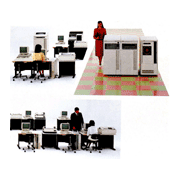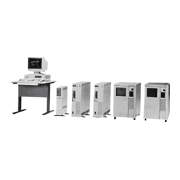This was a series of office computers(∗) from Toshiba, based on a single architecture and ranging from desktop machines to small general-purpose machines. (∗ Office computers are small business computers used in offices.) The top-end Q-800 machine was marketed in 1984, and the lower-end machines (the Q-700, Q-600, Q-500, Q-200 and Q-100) were marketed in 1985, thus completing the series.
Compared with conventional office computers, which focused on data processing, the Q Series aimed to be a core computer for OA (Office Automation), so Toshiba retired the "Office Computer" label, and called these machines "Total OA Processors".
The Q Series had the following features:
(1) Development of an 8Kgate gate array as the CPU
(2) Greater compactness due to the use of 256 kilobyte LSI memory and a 5-inch magnetic disk
(3) Professional image processing capability and facsimile transmission capability using a J-5070 dedicated workstation for image processing, a processor for image processing, and a facsimile communication control mechanism
(4) Migration of the "DPNET" horizontal/vertical distributed processing capability feature (perfected with the DP Series) -- TOPNET
(5) Features for OA
-OACALC3 (Spreadsheet)
-OAJDES (Document creation)
-OAGRAPH (Graphing)
-OADRAW (Drawing)
The Q Series was continued by the Q Series E Type models (Q-700E, Q-600E, Q-500E, Q-400E, Q-300E and Q-50E) which were marketed in 1961. The Q Series E Type models used a CPU based on a 20,000 gate CMOS gate array, and super-integration technology for integrating multiple LSIs into a single chip.

- Home >
- Historical Computers in Japan >
- Office Computers >
- TOSBAC Q Series
【Toshiba】 TOSBAC Q Series
 |  | |
| TOSBAC Q Series Single Architecture Computer | Q Series EX TOSBAC Q Series EX Type |
All Rights Reserved, Copyright (C) Information Processing Society of Japan
